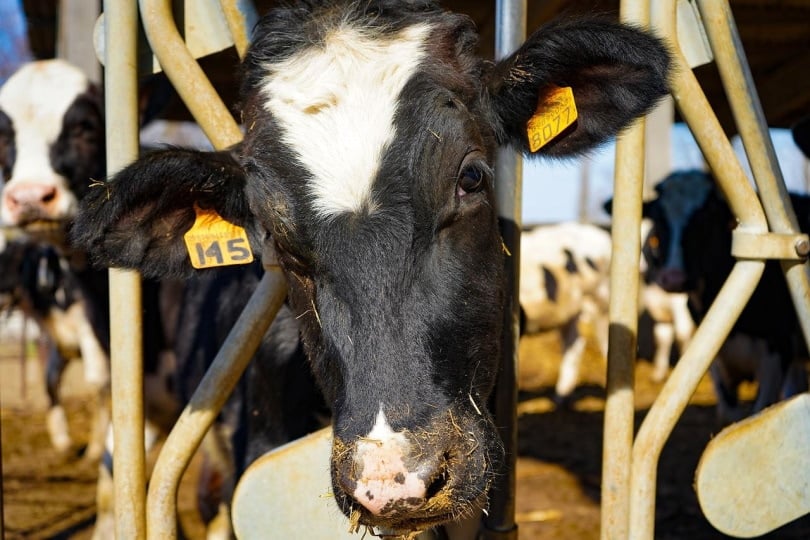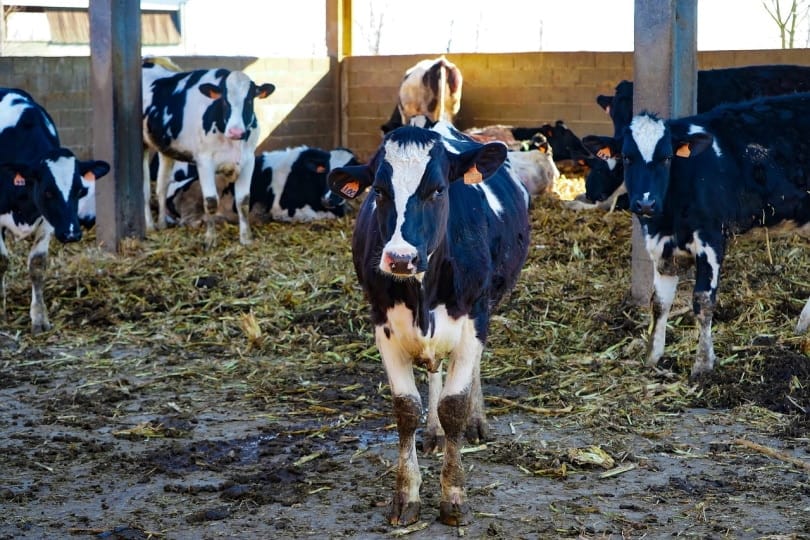The Holstein-Friesian cattle, otherwise known as Friesians, is a large, horned cattle with a gentle nature and is popular due to its high milk production. On top of being a good milk producer, the Friesian is also coveted for its meat.
If you were to drive across America’s heartland, the chances are good that you’ll see many Friesian cattle grazing in pastures. This breed can easily withstand the coldest winters of the Midwest and the hot and humid weather of the Southwest.

Quick Facts About Friesian Cattle
| Breed Name: | Holstein-Friesian |
| Place of Origin: | Holland and Germany |
| Uses: | Milk and meat |
| Bull (Male) Size: | 1,700 pounds |
| Cow (Female) Size: | 1,500 pounds |
| Color: | White with black patches, white with red patches |
| Lifespan: | 15 – 20 years |
| Climate Tolerance: | All climates |
| Care Level: | Moderate |
| Milk and Meat Production: | Excellent |
Friesian Cattle Origins
The Friesian cattle breed hails from the Dutch provinces of North Holland and Friesland, and the area of northern Germany called Schleswig-Holstein. For about 2,000 years, Friesian cattle were highly valued for their milk-producing abilities. Today, the Friesian continues to be popular as it’s the most widespread cattle breed in the world.

Friesian Cattle Characteristics
Friesian cattle are large animals that tip the scales between 1,500–1,700 pounds, reaching the same frame size and weight as pure Holsteins. In addition to their massive size, Friesian cattle are easily recognized by their distinct white and black or white and red coloring.
Male Friesian calves are very valuable because they produce large amounts of beef when they’re fully grown, even though the females are mostly used for dairy production. Either way, the robustness and usefulness of this breed are strengths of the Friesian cattle that are greatly appreciated by farmers the world over.
Uses
Throughout a Friesian cow’s lifetime, she will produce about 6,900 gallons of milk per year, making them ideal for dairy production. In the US, Friesian cattle produce nine-tenths of the total milk supply, even though the milk has a low butterfat content.
It’s quite easy for farmers to fatten up young Friesian calves so they grow into big meat producers. This is why male Friesians are often kept longer than other breeds—because they’re known for producing lean, delicious beef and lots of it!

Appearance & Varieties
Friesians are large, beautiful animals with distinctive black and white or red and white coloring. While it’s not common, some Friesians have black, red, and white colors all over. This mixed coloring is known as blue roan, and it’s produced by white hair mixing with black hairs, giving the cattle a bluish tint.
Friesians are very hardy and strong and easily adapt to all types of weather. Because they’re so adaptable, this breed is found worldwide, although most Friesians live in Europe and the USA. These are well-behaved cows with an even temperament that are moderately easy to handle.
The past five decades have become known as the “golden age of Friesian breeding“ since new breeding techniques have been created to produce large herds of top-quality bulls ready to enter the breeding arena.
Today, there are three main descendants of the Friesian bull: the Round Oak Rag Apple Elevation, the Pensate Ivanhoe Star, and the Hilltop Apollo Ivanhoe. These breeds have helped create hardy cattle in both the US and UK.
Population/Distribution/Habitat
Friesian cattle are commonly found in Holland, Denmark, Austria, Switzerland, Germany, the UK, and the US. However, because Friesian heifers are such good milk producers, you can find these cattle in over 150 countries the world over and especially in places that produce a lot of dairy products.
These dual-purpose cattle are especially popular among farmers that don’t have huge farms to keep both dairy and beef cattle. In this case, Friesian bulls are often kept longer than usual, so they can be slaughtered for their high-quality beef.
In the US, it’s common to find these beautiful big cattle on farms all across the country because they are used for both milk and meat production. Kids in youth organizations, like 4H, often get involved with raising Friesian cattle as a hobby.
Are Friesian Cattle Good for Small-Scale Farming?
Friesian cattle are large animals that like to graze. If you have a small-scale farm and would like to raise cattle, you can have a few Friesians on your farm as long as you have adequate room for these big beasts! They are easy-going cattle that don’t put up much of a fuss when being cared for and milked.
Like other cattle, Friesians need plenty of sunshine, lots of room, an abundance of water, and lots of nutritious food to keep them healthy and happy. These animals also need shelter and a clean living environment. Additionally, Friesians need regular grooming and hoof care to keep them in tip-top shape.

Conclusion
If you’ve traveled across America, you’ve probably seen lots of Friesian cattle on your journey, as this is one of the country’s favorite cattle breeds! This cattle breed is characterized by its black and white or red and white coloring and its ability to produce lots of milk and lean meat. It’s an easy-going animal that can be kept on a small-scale farm as long as you have some basic cattle know-how and plenty of room for them to graze.
Featured Image Credit: Pascvii, Pixabay
